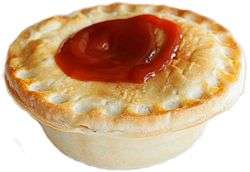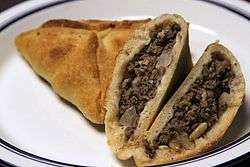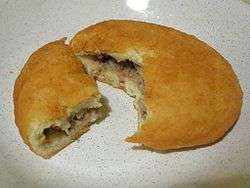Meat pie
A meat pie is a pie with a chunky filling of meat and often other savory ingredients. They are popular in the United Kingdom,[1] Australia, Ghana, Nigeria, Europe, New Zealand, Canada, Zimbabwe and South Africa.
 Australian meat pie with tomato sauce | |
| Type | Savory pie |
|---|---|
| Main ingredients | Meat, pastry |
History
Meat pie is found in the Neolithic Period, around 9500 BC. The ancient Egyptians' diet featured basic pies made from oat, wheat, rye, and barley, and filled with honey and baked over hot coals.[2]
The Greeks used a flour-water paste resembling pie pastry, and filled it with meat.[3] These pies were usually fried or cooked under coals. The Romans adopted them, using a variety of meats, oysters, mussels, lampreys, and fish as filling and a mixture of flour, oil, and water for the crust. This 'pastry' cover was not meant to be eaten and was thrown away.[3] In Northern Europe, cooks created the pastry using fats like lard and butter to make stiff dough to hold an upright pie.[4] These medieval pastry dishes were called "coffins/coffyns", which means a basket or box. According to Janet Clarkson in Pie: A Global History, the "coffins" were:
- savory meat pies with the crusts or pastry being tall, straight-sided with sealed-on floors and lids. Open-crust pastry (not tops or lids) were known as "traps." These pies held assorted meats and sauce components and were baked more like a modern casserole with no pan (the crust itself was the pan, its pastry tough and inedible). These crusts were often made several inches thick to withstand many hours of baking.
Some historians suggest the tough, almost inedible, crust was given to the servants while the lords and ladies of the house ate the contents.[3]
This pastry became a common dish in medieval times, and by the 14th century, came to be called a "pye" or "pie". The etymology of the word is unknown, but may be related to the magpie (also called "pie"), perhaps because both were spotted, or because the bird collects miscellaneous articles.[5]
The French and Italians specialized in redefining the pastry of the pie, making it flakier and tastier by new methods of adding butter, rolling, and folding the dough. In 1440, the Paris pastry guild was recognized and started to expand their product—and so something like the modern day crust began to be used.[3]
Missionaries and explorers spread the meat-based pie dish across the globe. The English Pilgrims of the North American colonies brought the recipes across the ocean with them. The crust of the pie was useful to preserve food during the long winter months in America (just as the pies were used in antiquity). But the pie was not considered popular there until the 1800s, and today in America meat pies have lost their popularity to be replaced with sweet pies.[6]
Regional variations


The Natchitoches meat pie is one of the official state foods of the US state of Louisiana.[7].
The Nigerian "meat pie" is similar to the Jamaican beef patty. It can be baked or fried, and the filling can be almost anything from minced beef, with potatoes and carrots (the most widely used) to just onions and tomatoes.
Latin American meat empanadas may be pies or more often pasties; different pastry shells and fillings are used, and they may be baked or fried. Empanadas usually contain much onion and green or red pepper, in combination with meat or fish. Empanada dough takes many forms, from those made with cornmeal to puff pastry.[8] Ground beef with olives, fried egg, pulled pork, diced steak, even cheese and salami are used in Chile, Argentina, Bolivia, Colombia, Ecuador, Puerto Rico and Peru for example.
Other well known varieties of meat pie include British meat pies, French-Canadian meat pie, and the Australia and NZ meat pie. An Irish meat pie is the steak and Guinness pie which consists of round steak with Guinness Stout Beer, bacon, and onions. It is served with potato chips and vegetables and is very popular in Irish pubs in Australia. In both Australia and New Zealand, the meat pie is a common convenience food often found in petrol stations and convenience stores and in New Zealand was once sold in a chain of fast-food restaurants.
Middle Eastern meat pies are called sfiha and contain ground beef, olive oil, plain yogurt, tahini, allspice, onion, tomatoes and pine nuts. Greek meat pies are called kreatopita and contain ground beef, onions and feta cheese. The filling for kreatopita is wrapped in phyllo dough. Indian meat pies are called samosa and usually contain peas, spiced potatoes, coriander, lentils, or ground beef or chicken and are often served with chutney.
See also
References
- Old English pies and puddings
- "Pies, History of Pies." What's Cooking America. N.p., n.d. Web. 22 Mar. 2011.
- Olver, Lynne. "Pie & pastry". The Food Timeline. Retrieved 5 Apr 2011.
- "A Brief History of Pie - TIME." Breaking News, Analysis, Politics, Blogs, News Photos, Video, Tech Reviews - TIME.com. N.p., n.d. Web. 22 Mar. 2011.
- Oxford English Dictionary, 3rd edition, s.v.
- "A Brief History of Pie - TIME." Breaking News, Analysis, Politics, Blogs, News Photos, Video, Tech Reviews - TIME.com. N.p., n.d. Web. 22 Mar. 2011.
- Clairborne, Craig (May 5, 1982). "Turnovers: A Dish With an International Heritage". New York Times.
- Casas, Penelope (1982). The Foods and Wines of Spain. New York: Alfred A. Knopf. pp. 52. ISBN 978-0-394-51348-5.
Bibliography
- "History of Pies". What's Cooking America. N.p., n.d. Web. 22 Mar. 2011.
Further reading
- Mack, Robert (Editor) (2007). Sweeney Todd: The Demon Barber of Fleet Street. Oxford University Press. ISBN 0-19-922933-3.CS1 maint: extra text: authors list (link)
